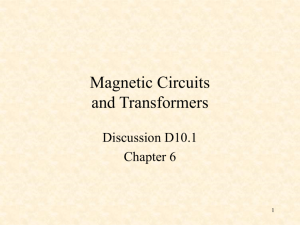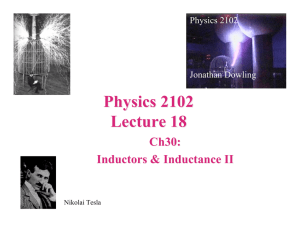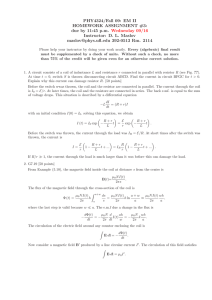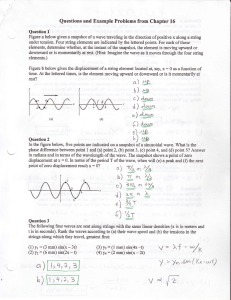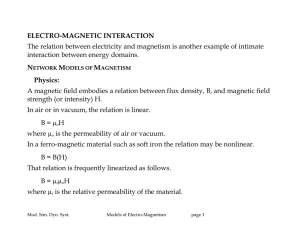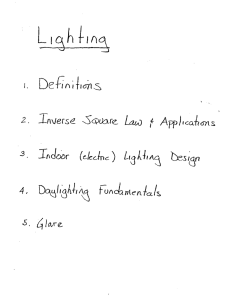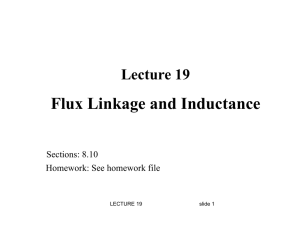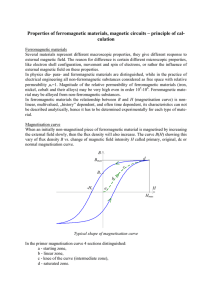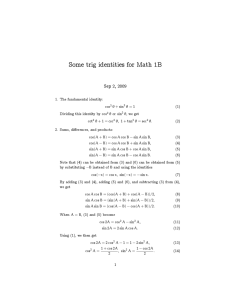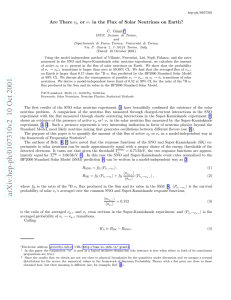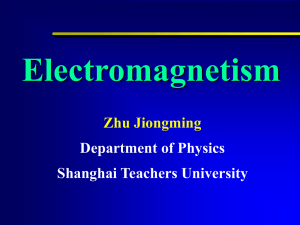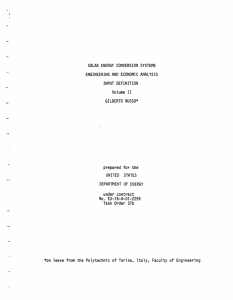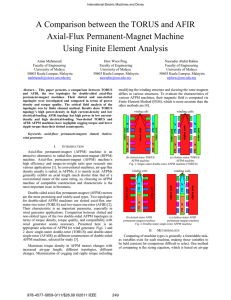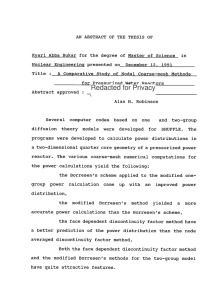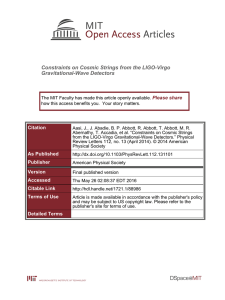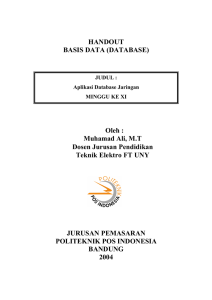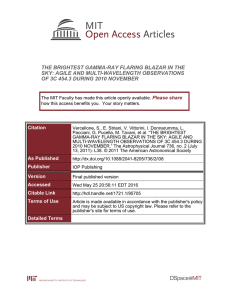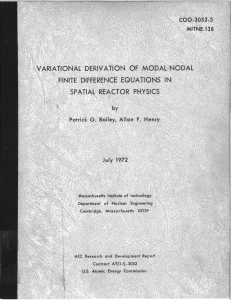Problem 6.18 from Jackson
advertisement
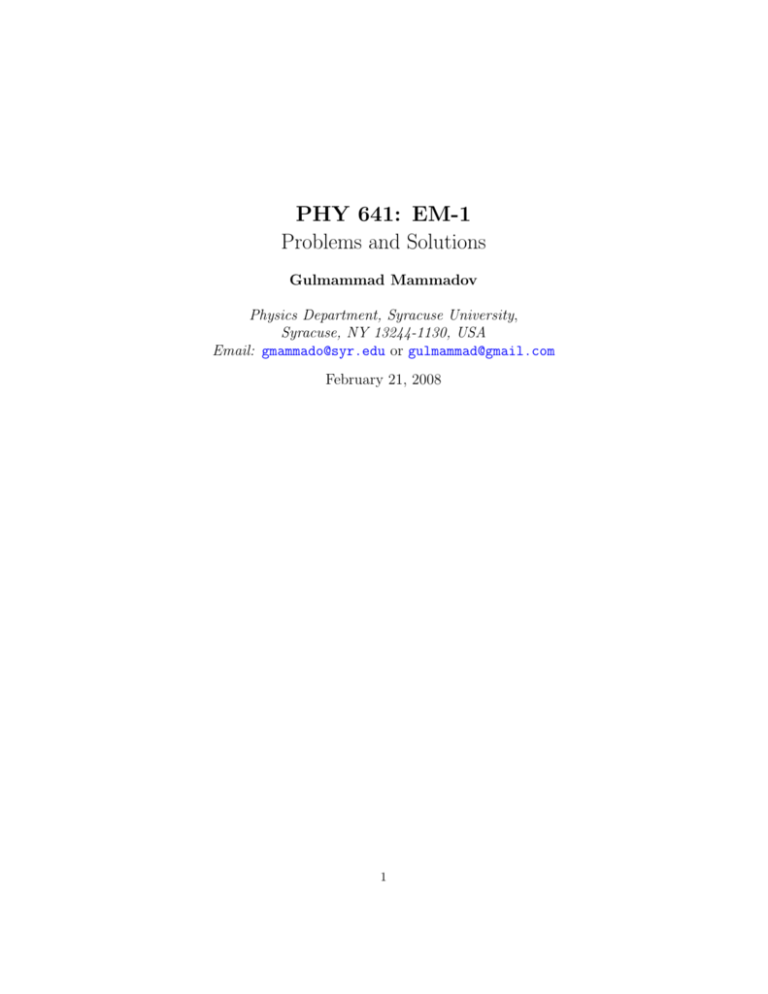
PHY 641: EM-1 Problems and Solutions Gulmammad Mammadov Physics Department, Syracuse University, Syracuse, NY 13244-1130, USA Email: gmammado@syr.edu or gulmammad@gmail.com February 21, 2008 1 Problem 6.18 (Jackson) Consider the Dirac expression A(x ) = g 4π Z L dI0 × (x − x 0 ) |x − x 0 |3 (1) for a vector potential of a magnetic monopole and its associated string L. Suppose for definiteness that the monopole is located at the origin and the string along the negative z axis. (a) Calculate A explicitly and show that in spherical coordinates it has components Ar = 0, Aθ = 0, Aϕ = g(1 − cos θ) g θ = tan 4πr sin θ 4πr 2 (2) (b) Verify that B = ∇ × A is the Coulomb-like field of a point charge, except perhaps at θ = π. (c) With the B determined in part b, evaluate the total magnetic flux passing through the circular loop of radius R sin θ shown in the figure (see in Jackson). Consider θ < π/2 and π/2 < θ separately, but always calculate upward flux. H (d) From A · dI around the loop, determine the total magnetic flux through the loop. Compare the result with that found in part c. Show that they are equal for 0 < θ < π/2, but have a constant difference for π/2 < θ < π. Interpret this difference. Solution: Since the string is along the negative z axis, then x 0 being a position vector from the origin to a given point on the string, has components (0, 0, −z) = (0, 0, −r0 ), while x with |x | = r is a position vector from the origin to an observation point. And also for an element of length on the string we have dI0 = dx 0 . (a) From the figure we see that dI0 × (x − x 0 ) has non-zero component only in the ϕ̂ direction, and so does A. |x − x 0 | = [(r cos(π − θ) − r0 )2 + r2 sin2 (π − θ)]1/2 = [(r cos θ − r0 )2 + r2 sin2 θ]1/2 (3) And dI0 × (x − x 0 ) = dx 0 × (x − x 0 ) = dr0 |x − x 0 | 2 r sin θ ϕ̂ = r sin θdr0 ϕ̂ |x − x 0 | (4) If we substitute (3) and (4) into (1), we get Z ∞ Z ∞ r sin θdr0 g ady g = Aϕ = 4π 0 [(r cos θ − r0 )2 + r2 sin2 θ]3/2 4π −r cos θ [y 2 + a2 ]3/2 with a = r sin θ and y = r0 − r cos θ. The last integral gives s ∞ g(1 − cos θ) g y 2 = Aϕ = 2 2 4πa y +a 4πr sin θ (5) (6) −r cos θ which is in agreement with (2). (b) Using (2) we can compute components of B = ∇ × A in the spherical polar coordinates (θ 6= π), ∂ ∂Aθ g 1 (Aϕ sin θ) − = (7) Br = r sin θ ∂θ ∂ϕ 4πr2 1 ∂ ∂Ar Bϕ = (rAθ ) − =0 (8) r ∂r ∂θ 1 1 ∂Ar ∂ Bθ = − (rAϕ ) = 0 (9) r sin θ ∂ϕ ∂r Therefore we see that B is the Coulomb-like field of a point charge. (c) If θ < π/2, the magnetic flux passing trough the circle with the radius R sin θ is Z Z Z 2π Z θ g g R2 sin θ0 dθ0 = (1 − cos θ) (10) Φ1 = B · dS = Br dS = dϕ 2 4πR 2 0 0 And if θ > π/2 Z Z Φ2 = B · dS = − 0 2π Z dϕ θ π g g R2 sin θ0 dθ0 = − (1 + cos θ) 2 4πR 2 (11) the minus sign comes because we consider upward flux. Then the total flux g g Φ1 + (−Φ2 ) = (1 − cos θ) + (1 + cos θ) = g (12) 2 2 (d) Since Aϕ is the only non-vanishing component of the vector potential, using (6) we have I I g(1 − cos θ) g Φ= A · dI = Aϕ dI = 2πR sin θ = (1 − cos θ) (13) 4πR sin θ 2 If we compare (13) to (10) and (11), we see that Φ = Φ1 while Φ = −Φ2 and Φ − Φ2 = g. This shows that there is a flux coming up along the z axis from the string. 3
